The Lost Inventions of Buckminster Fuller (Part 3 of 3)
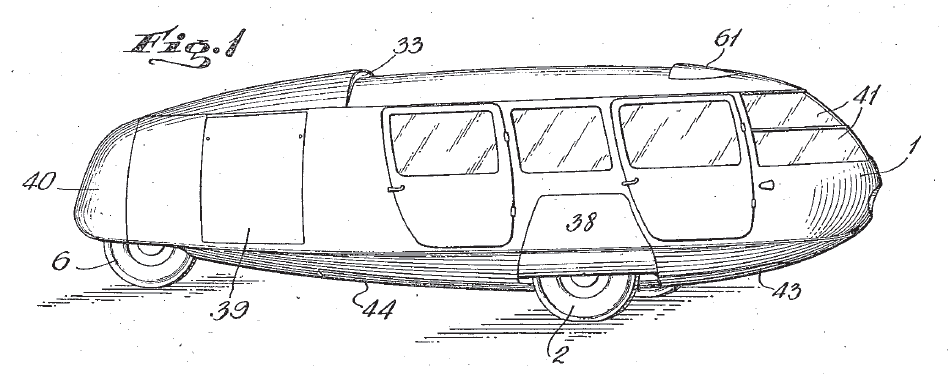
The Lost Inventions of R. Buckminster Fuller is a three-part investigation into the inventions of Buckminster Fuller. These essays can serve as companion essays for two previous books by and about Fuller: Inventions (Fuller, St. Martin’s Press 1983) and The Dymaxion World of Buckminster Fuller (Marks and Fuller, Doubleday 1973). Ownership of these two books is not necessary for reading these essays. Page numbers without citations are from Inventions Fuller made many claims about his inventions, claims which are confirmed or called into question by these essays. A new appreciation for Fuller’s innovations is the result.
Fuller claimed that his life goal was to provide humanity with the means to save itself from itself and from natural disasters. To that end Fuller could have given his inventions up to the public domain, making them more accessible to more people. But Fuller sought, obtained and defended patents for many of his inventions, for two reasons.
First, Fuller hoped that the long-term and public nature of the US Patent Office would serve as a long-term and public record of his work. Fuller wrote in Inventions: “The public record established by my patents […] can serve as a critical appraisal of the historical relevance, practicality, and relative effectiveness of my half-century’s experimental commitment to discover what, if anything, an individual human being eschewing politics and money-making can do effectively on behalf of all humanity.”
Second, Fuller hoped to prevent others from profiting from his inventions. Donald W. Robertson served as Fuller’s patent attorney and wrote about his experience in The Mind’s Eye of Buckminster Fuller (Robertson, St. Martins 1983). Robertson described why Fuller sought patents: “While Fuller did not wish to seek patent profits by selling efforts, he was adamant in seeking to forestall efforts of others to profit by making unauthorized use of his inventions.” Fuller defended his patent interests. Fuller’s archive includes legal disputes over royalties with North American Aviation between 1958 and 1961 and with Ernest Okress between 1978 and 1979. According to Siobhan Roberts’ book on mathematician Donald Coxeter, King of Infinite Space (Roberts, Walker & Co. 2006), Fuller’s patent on the Radome was defended in Canada by the United States Department of Defense. Fuller sought and sometimes obtained intellectual property rights in Argentina, Belgium, Bolivia, Brazil, Canada, Chile, Columbia, The Congo, Costa Rica, El Salvador, Finland, France, Greece, India, Iran, Iraq, Israel, Italy, Jamaica, Japan, Jordan, Kenya, Korea, Luxembourg, Mexico, New Zealand, Nicaragua, Norway, Pakistan, Panama, Paraguay, Poland, Portugal, South Africa, Spain, Switzerland, Turkey, the United State, the United Kingdom, Uruguay, Venezuela and West Germany.
All of Fuller’s inventions are lost in some way. All of Fuller’s U. S. patents are lost in that they have expired. Some of Fuller’s patents expired in his lifetime. This is due to his being unable to afford a renewal, or his deciding to let a patent expire, or perhaps neglect. Many of Fuller’s patents lost their references to earlier patents by other inventors. That is, what Fuller claimed he invented was in fact invented by someone else. Sometimes Fuller was ignorant of prior work, such as the octet-trus constructions of Alexander Graham Bell. Sometimes Fuller stole ideas whole-cloth, such Kenneth Snelson’s sculptures re-branded as Fuller’s tensegrity. Some of Fuller’s patents are lost because they have yet to go into production, existing only as scale models. Perhaps now that Fuller’s patents have expired some of them can be tested against Fuller’s claims. Perhaps the fog gun could be tested in arid environments, for instance. Many of Fuller’s patents are lost to the curious because they are not always filed under their popular name. The patent for the geodesic dome is to be found under the title ‘Building Construction,’ which has likely caused some researchers difficulty in finding it. Some of Fuller’s patents are lost because they are under-documented. Automobile restoration firm Crosthwaite and Gardiner had access to nearly all the information ever produced about the Dymaxion Car, but at times had to make their best guess in the creation of Dymaxion Car #4 because detailed schematics and photographs were not available. The credits to many of the illustrations in Inventions are lost. Illustrations appear in the book without further information. The photograph on the front cover is a 36-foot geodesic dome made by students at the University of Minnesota and assembled in Aspen, Colorado in 1952. Additional photographs of this dome can be found in Dymaxion World illustrations 334-339. The end papers show the paperboard dome of 1954. Page vi shows Fuller with a partially-assembled model of the 4D House in New York City in 1929. Page xi shows Fuller at Black Mountain College in 1948. Pages xvii and xviii appear to be Fuller at the Montreal World’s Fair dome. The photographs on pages xiv, xxvi-xxvii, xxxi and xxxii are of unknown origin.
Tetrahedron City is a floating city proposed by Fuller in the early 1960s and described in Dymaxion World. Fuller never sought a patent for Tetrahedron City. Tetrahedron City is an equilateral tetrahedronal city two miles long at its base edge, housing one million people in three hundred thousand apartments. Each apartment would have an ocean front balcony. City infrastructure is located in the interior of the tetrahedron, airstrips are located along the base exterior. The foundation of Tetrahedron City is made up of hollow box-sectioned reinforced concrete, providing buoyancy. The size of the city provides stability even in ocean storms.
Tetrahedron City would be slightly more than 1.6 miles in height. This is three times the height of the Burj Khalifa in Dubai, United Arab Emirates, the tallest man-made habitat in history as of 2012 at 2,723 feet. Tetrahedron City would have an overall population comparable to Calgary, Canada and a population density comparable to Hong Kong, China. Tetrahedron City would be significantly more spacious and less populated than New York City, New York or Mexico City, Mexico. These cities have challenges but they cannot be said to be failures. The Robert Taylor Homes of Chicago, Illinois, however, were not able to meet their challenges. The Robert Taylor homes included two miles of housing spread among twenty-eight buildings, each sixteen stories in height. The Robert Taylor homes housed up to 27,000. In short order, these buildings became so rife with violence, poverty, arson and drug abuse that the only solution to these problems was to re-locate the residents and demolish the buildings. A similar outcome occurred in the Cabrini-Green buildings, also located in Chicago. The problems of these buildings were blamed both on gangs and a lack of green space or private space. How Tetrahedron City might address these problems remains to be determined.
Triton City is a floating city proposed by Fuller in the early 1960s and described in Dymaxion World. Fuller never sought a patent for Triton City. Triton City was designed to house up to five thousand people in one-fourth of a square mile, approximating the population of a small town under one roof. Triton City was to be a proof-of-concept module for the eventual creation of Tetrahedron City. The patron for Triton City was Matsutaro Shoriki. Shoriki is considered the father of Japanese professional baseball, and was the owner of newspapers and television stations. He was also considered the father of Japanese nuclear power, was under the pay of the Central Intelligence Agency to establish pro-USA television stations, and was a Class-A war criminal. Shoriki died after commissioning Fuller to design Tetrahedron City.
Fuller proposed the World Game in 1961 while lecturing at Southern Illinois University. The World Game was played on a large scale Dymaxion map representing Earth with students representing the population of the world. The goal of the game is to provide advanced access to goods and services to all people without resorting to war. The rules of the game are based on information on goods, services and transportation available to the World Game Institute. The information-gathering phase of the World Game echoes Fuller’s survey of industry from decades earlier. World Game has been played by students around the world to varying degrees of success. By the early 2000s the intellectual property of the World Game Institute had been purchased by O.S.Earth.
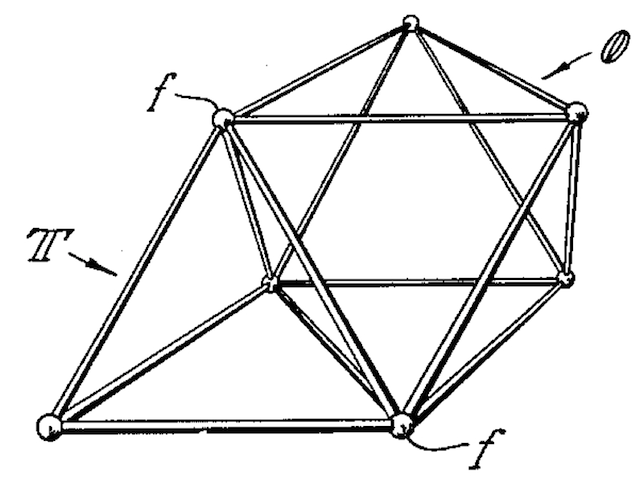
The Octet Truss is a building component made up of a tetrahedron and an octahedron with equal edge lengths. The Octet Truss is called Synergetic Building Construction in patent 2,986,241 (30 May 1961). Canadian patents were awarded in 1957. Grunch of Giants claims the Octet Truss was designed in 1933 and prototyped in 1949. Fuller claims that he owned a trademark, copyright and patent on the octet truss and that this was granted in part because he had shipped the structure across state lines. Shipping an invention across state lines is not a prerequisite for being granted a patent. In Genius At Work: Images of Alexander Graham Bell by Dorothy Harley Eber, Fuller claims to have been unaware of Bell’s octahedron-tetrahedron towers and kites. Bell was granted patent 856,838 for Connecting Device for the Frames of Aeriel Vehicles and Other Structures on 11 June 1907. This patent shows an modular octahedral-tetrahedral system “adaptable to a great variety of structural uses.” The octet truss is in use in the International Space Station, as Fuller claimed it would be. Closer to home, lighting rigs in theaters often use an octet-truss structure.
The Octet Truss is preceded by similar inventions, although there is no indication that Fuller was aware of them.
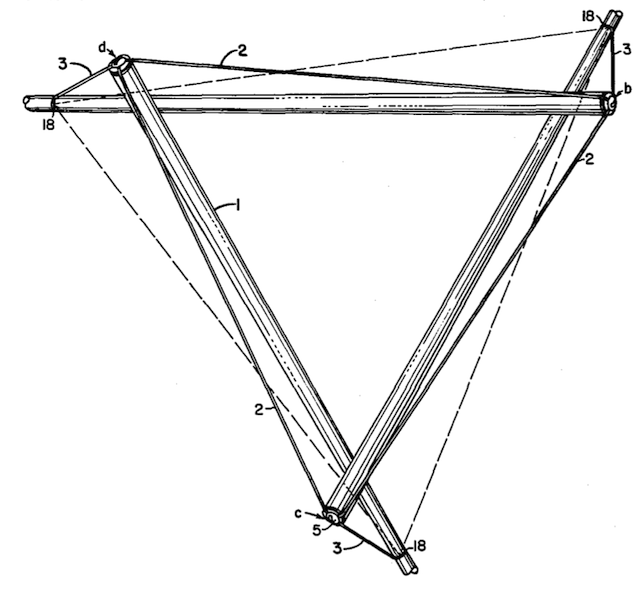
Tensegrity is a form of sculpture in which flexible wires are held taunt by struts, and the struts are held in place by the wires. Tensegrity is called Tensile-Integrity Structures in 3,063,521 (13 November 1962). Non-Symetrical Tensegrity is called Non-Symetrical Tension-Integrity Structures in 3,866,366 (18 February 1975). Canadian patents were awarded in 1960. Non-symetrical Tensegrity was patented in Canada, Great Britain, India, Italy and Japan in 1977. In Grunch of Giants, Fuller claims to have designed tensegrity in 1929. Buckminster Fuller invented the word tensegrity, but the structure described as a tensegrity was invented by Kenneth Snelson. The November 1990 issue of International Journal of Space Structures magazine includes a letter to the editors from Snelson on his sculptures and Fuller’s seizure of them.
When we got together again in June [1949] I brought with me the plywood X-Piece. When I showed [Fuller] the sculpture, it was clear from his reaction that he hadn’t understood it from the photos I had sent. He was quite struck with it, holding it in his hands, turning it over, studying it for a very long moment. He then asked if I might allow him to keep it. […] That original small sculpture disappeared from his apartment, so he told me at the end of the summer. [In] January 1951 he published a picture of the structure in Architectural Forum magazine and, surprisingly, I was not mentioned. When I posed the question some years later why he accredited me, as he said, in his public lectures and never in print, he replied, ‘Ken, old man, you can afford to remain anonymous for a while.‘
The two tensegrity patents in Inventions cite Dymaxion World, and illustration 265 in Dymaxion World mentions Snelson. The sculpture on page 179 was made by students at the University of Oregon in 1959. The sculpture on pages 184-185 was made by students at North Carolina State College in 1950. The sculpture on page 190 is claimed to have been exhibited at the Metropolitan Museum of Art in New York in 1959 but perhaps instead it was exhibited at the Museum of Modern Art in that same year, along with a geodesic dome and octet trus sculpture. At no time has a tensegrity been been as a shelter. Not for a home, a bridge, a garden shed, a bird house or any other sort of shelter. Tensegrities are fascinating sculptures but so far have no use in architecture.
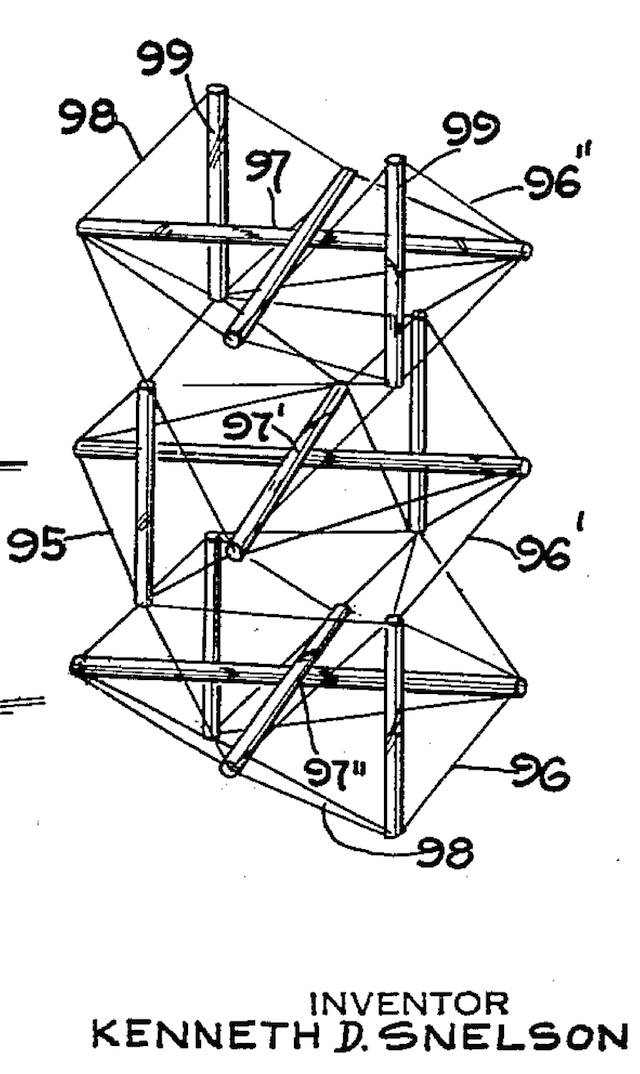
Tensegrity is preceded by the sculptures of Kenneth Snelson, and Fuller was entirely aware of it.
The Geoscope was discussed in Fuller’s 1962 book Education Automation. The Geoscope was a proposed two-hundred-foot diameter sphere suspended by cables and covered in computer-controlled electric lights. Viewers outside or inside the Geoscope could see representations of migrations of people, goods and services on this miniature Earth. As with the Dymaxion Map, Fuller hoped that viewing the Earth as a whole would inspire whole-earth thinking rather than nationalist thinking.
Fuller never sought a patent for the Geoscope. It is preceded by the patent Exhibition Structure 655255 by Herbert P. W. Lyouns, awarded 7 August 1900. Exhibition Structure was a large globe covered in electric lights. Viewers outside or inside the Exhibition Structure could see representations of migrations of people, goods and services on this miniature Earth. Lyouns wrote: “The space within the globe will be divided by suitable partitions into rooms hallways and exhibition booths or apartments and an important feature of the invention is to locate these various rooms and apartments in such relation to the outlines on the outer surface of the globe as to permit the products of any particular country or city to be exhibited adjacent to the location of such country or city upon the map delineated upon the surf arc of the globe. Thus an important educational result is accomplished the visitor being enabled to associate in his mind the peculiar products of different countries with the geographical locations of such countries.”
The Geoscope is preceded by similar inventions, although there is no indication Fuller was aware of them.
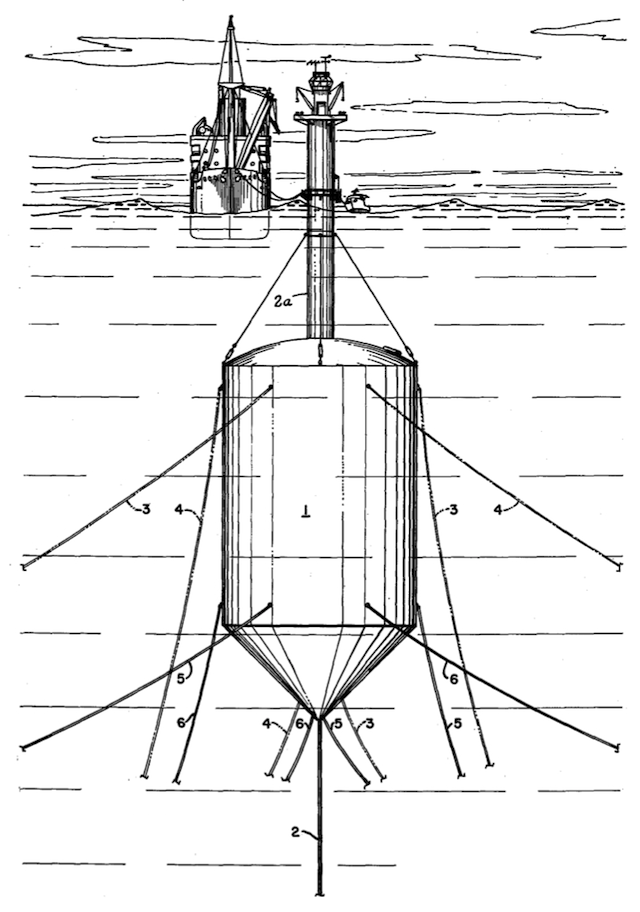
The Submarisle (Undersea Island) is a buoyant underwater shelter anchored by cables to the sea floor. The Subgarisle is called an Undersea Island in patent 3,080,583 (12 March 1963). Jacques Cousteau’s Conshelf One housed two researchers for seven days in 1962, and Conshelf Two housed ten researchers for thirty days in 1963. The Submarisle is distinctive from Cousteau’s habitats in that it is buoyed on triangulated lines rather than resting on the sea floor. The Submarisle floats upward on three wires as Fuller’s Hanging Storage Shelf Unit hangs down from three wires.
The world has yet to see giant cargo submarines in need of submarisle docks. But drug runners are using very small submarines to transport their goods in the early 21st Century. Perhaps there are illegal and hidden submarisles in the world.
The Submarisle is the invention of Buckminster Fuller.
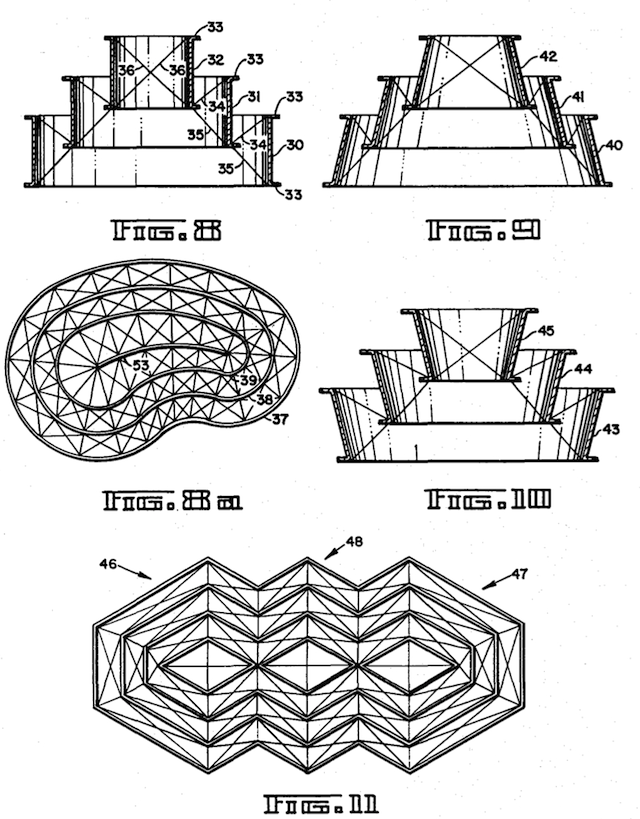
The Aspension (Suspension Building) is an architectural technique in which higher-up components are suspended by lower-down components. The Aspension Building is called a Suspension Building in patent 3,139,957 (7 July 1964). This is another invention by Fuller that has never been utilized commercially, although aspension structures exist as models.
The Aspension Suspension Building is a form of the sculptures of Kenneth Snelson, and Fuller was entirely aware of it.
The Octa Spinner (circa 1965) is a means of weaving tensegrity structures. The Octa Spinner has no patent. In Inventions, Fuller writes: “I did not go through with the octet spinner patent after filing because the expense of patent work is very great, and I’m not in the manufacturing world, and I felt that it would not be worth carrying any further.” The Mind’s Eye of Buckminster Fuller, however, claims that Fuller’s initial application was rejected and that he only ended the process after carrying it further into a second application. The Stockade patents are part of the manufacturing world, and much of his work on shelters could be considered the same. The Chronofile contains a folder labeled “Original Patents file: Octa Spinner (application withdrawn - case no. 349.021) March, 1965.”
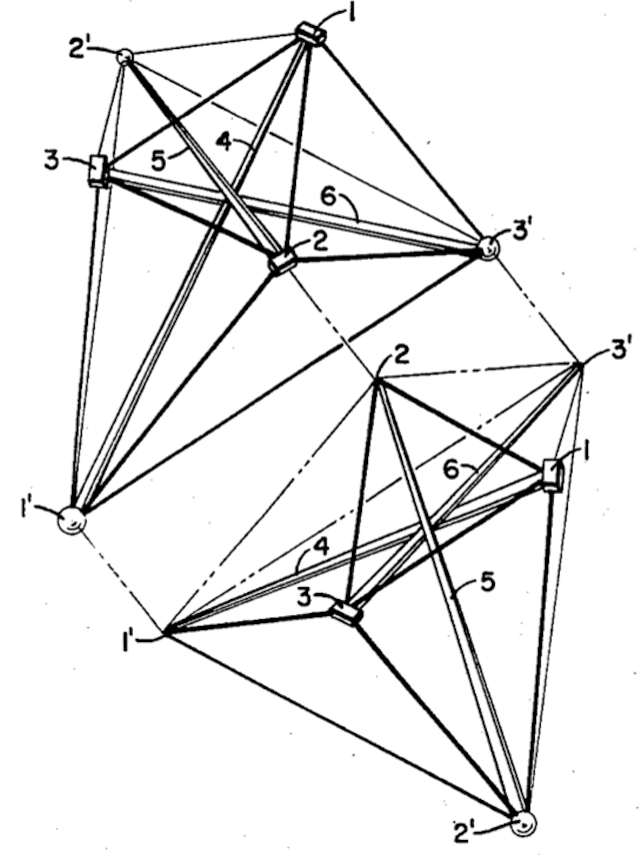
The Star Tensegrity (Octahedral Truss) is a variety of tensegrity. The Star Tensegrity is called an Octahedral Building Truss in patent 3,354,591 (28 November 1967). Canadian patents were awarded in 1968. The photograph on page 248 shows the Union Carbide Tank Car Company Dome in Baton Rouge, LA USA. This dome was constructed in 1958 and demolished in 2007. The Octa-Hedronal Truss received a patent in Japan in 1965.
Tensegrity is preceded by the sculptures of Kenneth Snelson, and Fuller was entirely aware of it.
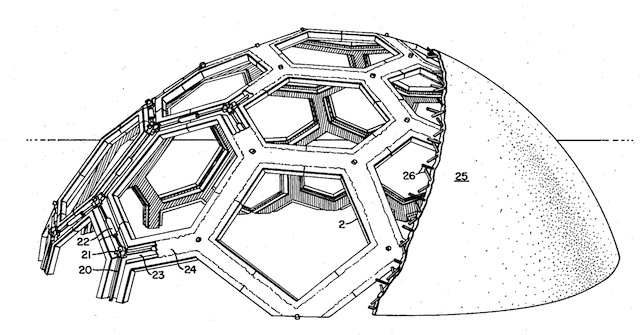
The Monohex (Geodesic Structures) is a variety of geodesic dome, made up of alternating hexagons and pentagons. The Monohex is called Geodesic Structures in patent 3,197,927 (3 August 1965). The photograph on pages 216-217 show the 50-foot Fly’s Eye dome built by John Warren. Additional photograph of this dome can be found on pages 210-211 of Buckyworks by J. Baldwin. The photographs on pages 222-223 are of unknown origin. The Monohex Geodesic Structure received a patent in Japan in 1979.
The Monohex Geodesic Structure, as a dome, is preceded by similar inventions. But the reduction of dome components to stackable interchangeable modules is a form unique to Fuller.
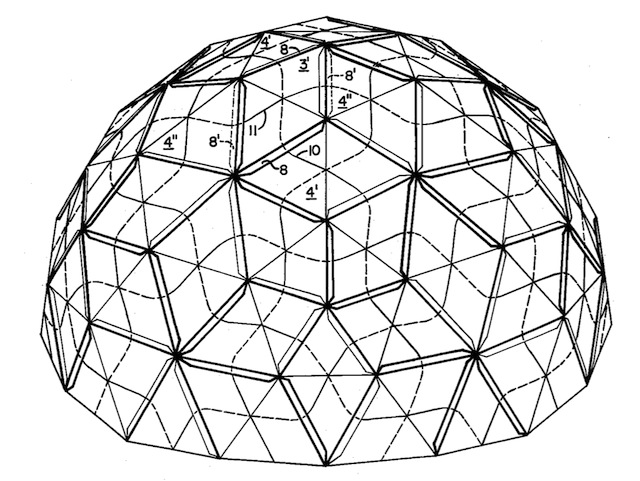
The Laminar Dome is a variety of geodesic dome, made up of alternating diamond shaped panels. The Laminar Dome is called a Laminar Geodesic Dome in patent 3,203,144 (31 August 1965). Canadian patents were awarded in 1961. The photograph on page 229 shows the same radome in illustration 415 of Dymaxion World, built by Western Electric.
The Laminar Dome, as a dome, is preceded by similar inventions. But the woven construction of this dome is a form unique to Fuller.
Energy Storage / Switching 1968-1969 is found in the Chronofile, housed at Stanford University. This is an invention in progress that is not otherwise documented.
Electronic Computer Energy Transformation 1969-1972 is found in the Chronofile, housed at Stanford University. This is an invention in progress that is not otherwise documented.
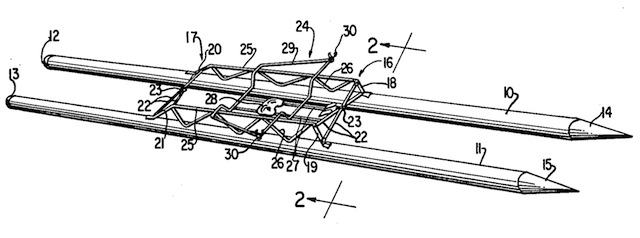
The Rowing Needles (Watercraft) is called a Watercraft in patent 3,524,422 (18 August 1970). Inventions does not give the filing date, which was 28 March 1968. In Dymaxion World illustration 298 this is called a minor invention of 1947. In Grunch of Giants, Fuller claims the rowing needles were invented in 1938 and prototyped in 1954.
Catamarans and outrigger canoes have existed since antiquity. As an avid sailor, Fuller would have been familiar with these crafts.
Cloud Nine is a floating city proposed by Fuller in Dymaxion World, published in 1973. Fuller never sought a patent for Cloud Nine. Fuller proposed that the air inside a one-mile-diameter geodesic sphere would weight more than the sphere itself. Sunlight would heat the surface of the sphere, heating the air inside, causing a temperature difference of the air inside and outside the sphere, and by this means the sphere would float upward. Fuller proposed many thousands of people could live in such a floating city, allowing it to drift or be guided.
The first manned hot air balloon (drifting) was demonstrated 1783 by the Montgolfier brothers. The first thermal airship (guided) was demonstrated in 1973, the year Dymaxion World was published. Stories of a city in the sky are found in antiquity. The Cloud Nine geodesic sphere, as a geodesic sphere, is preceded by similar inventions. But Buckminster Fuller’s Cloud Nine is an original proposal for how a floating city might be made.
Tiago Barros made a similar proposal nearly forty years later with his Passing Cloud.
The Passing Cloud is an innovative and environmentally friendly method of transportation that doesn’t require expensive steel tracks or concrete highways. It is made of a series of spherical balloons that form the shape of a cloud. Its inner stainless steel structure is covered with heavy weight tensile nylon fabric. During the journey, It moves according to prevailing winds speed and direction at the time of travel. Since it moves with the wind, no wind is ever felt during the trip, offering the passengers a full ‘floating sensation.’
Metabolics Money 7/11/1973 is found in the Chronofile, housed at Stanford University. This is an invention in progress that is not otherwise documented.
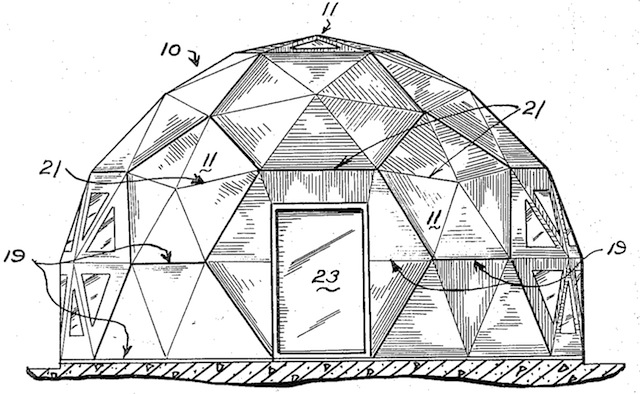
The Geodesic Hexa-Pent is called a Geodesic Pentagon and Hexagon Structure in patent 3,810,336 (14 May 1974). The patent was granted to Shoji Sadao and assigned to Fuller & Sadao, Inc. The Hex-Pent Dome was patented in Australia, Canada, India, Israel and Italy in 1973. Shoji Sadao was a former student of Fullers. Sadao was involved in the creation of the icosohedral Dymaxion Map (known as the Raleigh projection) and in the creation of the Expo ’67 dome in Montreal. In Inventions, Fuller claims that the Hexa-Pent dome was developed by Sadao and jointly named by Sadao and Fuller. The Hexa-Pent dome is preceded by patent 3,114,176 of Alvin E. Miller (17 December 1963).
The Geodesic Hexa-Pent dome, as a dome, is preceded by similar inventions. This patent was never claimed by Fuller. The Hexa-Pent dome was featured in the May 1972 issue of Popular Science magazine. The plans for the dome advertised on page 139 of this issue represents the only time Fuller himself sold dome instructions to the general public.
Helicopter Rotor Sail 1976 is found in the Chronofile, housed at Stanford University. This is an invention in progress that is not otherwise documented.
Fuller’s name for his thoughts was synergetics. Synergetics is a system of mathematics, an ethical system, a philosophy, an aesthetic, a form of poetry and more. Synergetics is the central invention of Fuller, with all the individual artifacts only special cases of synergetics. Hugh Kenner wrote that synergetics puts Fuller in the transcendentalist school, with his ancestor Margret Fuller. Elements of synergetics appear in Fuller’s earliest lectures and writing, but the 1975 publication of Synergetics can be considered a first full statement of his intent.
Fuller discovered a formula for predicting the number of spheres found in the outer shell of closest-packed spheres. That formula is ten times f squared plus two, with f equal to the frequency (number of layers). One sphere can be most closely surrounded by twelve identical spheres; six around the first sphere’s equator, three nestled underneath and three nested on top. This comprises the first layer, thus ten times one square plus two equals twelve, the number of spheres surrounding the original sphere. A second layer will have 43 spheres, a third will have 92 spheres, and so on. Fuller’s formula can predict the number of spheres on the outer shell of any array of closest-packed spheres.
Fuller formalized his Primitive Hierarchy of shapes in Synergetics 988.20 (1975, 1979). Fuller began with the claim thoughts are made up of ideas and that these ideas are spherical in shape. One idea is insufficient to form a thought, as would be two. Three ideas are close to a thought, but the connection between them has surface but no volume. Four spherical ideas packed together form a tetrahedron, a shape that has volume. Thoughts, therefore, are shaped like tetrahedrons. Fuller claimed that for this reason tetrahedrons were primal shapes and a more worthy basis for mathematics than cubes, grids or other systems.
If the volume of a tetrahedron is equal to one, then other shapes can be assigned volume in relation to the tetrahedron. The next larger shape in the Primitive Hierarchy is the cube. The volume of a cube is obtained by using the dual of the tetrahedron. To obtain a dual of a shape, make new edges at right angles to the center of the edge of a shape. The duel of a tetrahedron is another tetrahedron. The vertices of a tetrahedron and its duel form a cube. That cube will have a volume of three. The duel of that cube will form an octahedron with a volume of four. The duel of that octahedron will form a rhombic dodecahedron with a volume of six. These four shapes are a sufficient introduction to the Primitive Hierarchy, although Fuller identified larger and smaller shapes in the series.
Johannes Kepler proposed a different concentric hierarchy of shapes in his 1596 book Mysterium Cosmographicum. Kepler used the platonic solid shapes, and arranged them from (smallest to largest) as octahedron, icosahedron, dodecahedron, tetrahedron and cube. The idea of arranging shapes within other shapes is an ancient one. The Primitive Hierarchy is preceded by similar inventions. The Primitive Hierarchy is unique to Fuller.

The Floating Breakwater is patent 4,136,994 (4 February 1975) and the Floatable Breakwater is patent 3,863,455 (30 January 1979). These are breakwaters that float on the surface of the ocean to control the movement of the water or contaminants in the water. Fuller claims that he produced Floatable Breakwaters but there are no photographs of them in Inventions. Inventions does not give the filing date for either of these patents, which were 10 December 1973 and 19 September 1977 respectively. Dozens of floating breakwater patents, some generating power like Fuller’s Floatable Breakwater, predate Fuller’s patents. Lancelot Kirkup was granted patent 226,663 for his breakwater “loaded so to float that its greatest diameter will be about at the water line” on 20 April 1880.
The Floating Breakwater and Floatable Breakwater are preceded by similar inventions, although there is no indication that Fuller was aware of them.
The Tensegrity Trus is a variety of tensegrity. The Tensegrity Trus is called a Tensegrity Module Structure and Method of Interconnecting the Modules in patent 4,207,715 (17 June 1980). The patent was granted to Christopher J. Kitrick. Fuller wrote in Inventions: “I authorized Chris to take out a patent on his invention, which by agreement I paid for and on the basis it be assigned to me.” Fuller is not listed as assignee in this patent.
Tensegrity is preceded by the sculptures of Kenneth Snelson, and Fuller was entirely aware of it.
De-Resonated Tensegrity Dome 1981 is found in the Chronofile, housed at Stanford University. This is an invention in progress that is not otherwise documented.
Methods and Apparatus for Constructing Spheres 7/1/1982 is found in the Chronofile, housed at Stanford University. This is an invention in progress that is not otherwise documented.

The Hanging Storage Shelf Unit is a shelf suspended from the ceiling. The Hanging Storage Shelf Unit is patent 4,377,114 (22 March 1983). Inventions does not give the filing date, which was 5 October 1981. Fuller claims the hanging storage shelf unit was built and used in a bookstore, perhaps the unit shown in the photograph on page 295. The book on the shelf in that photograph is Dymaxion World thus the photograph could have been taken no earlier than 1973. The hanging storage shelf unit is not unlike the 1944 criss-cross tensionally supported table found in illustration 300 in Dymaxion World.
Patent 1,5952,466 (27 March 1934) was awarded to Alexander Sjodin, Charles J. Olund and Robert J. Moody. This patent is cited in Fuller’s patent for the Hanging Storage Shelf Unit. This Display Rack was suspended from above. Theodore Pollard was awarded patent 3,866,364 (18 February 1975) for Modular Structure for Use in Merchandising Operations. This consists of a hexagonal shelf that can be hung by wires.
The Hanging Storage Shelf Unit is preceded by similar inventions, and Fuller was aware of at least one of them.
Conclusion
R. Buckminster Fuller described himself as a “terrific package of experiences.” The record of Fuller’s uncredited duplication of prior work suggests that he was at times a terrific package of other people’s experiences. The greatest invention of Richard Buckminster Fuller was the character Bucky.
- Trevor Blake
Trevor Blake is the author of the Buckminster Fuller Bibliography, available at synchronofile.com